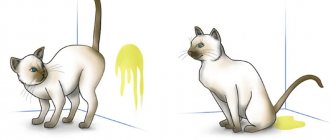10700Pavel
1
How to stop a kitten from pooping in the wrong place? How to accustom your furry pet to the cat litter box? These are the most pressing questions that interest everyone who is planning or has already adopted a cat as a pet. Representatives of the cat family are very clean animals, but if useful, correct behavioral skills are not instilled in a timely manner, they can cause a lot of problems. At the same time, walking on the dining table and sharpening claws on upholstered furniture may seem like innocent pranks compared to puddles on the carpet or in other secluded places and a specific smell. The following useful tips will help you if the kitten begins to shit in the wrong place.
When to litter train a kitten
You need to carefully prepare for the arrival of a domestic kitten. Buy several trays and place them in different corners. Absorbent diapers may be required. It is necessary to begin training immediately. When the baby starts fussing, you can pick him up and carry him to the container.
In the end, he himself will choose a container to relieve his needs. Extra trays are removed, and the ones you like are moved to the toilet. The pet must understand that if he did something correctly, he will receive a reward treat.
Let's get started with education
Most kittens learn to walk when they need to, following the example of their mother cat. Therefore, if the pet is already old enough and not taken from the street, then, as a rule, there are no problems with its upbringing. But if the kitten is street and still quite small, then the owners must direct its actions in the right direction. It is important to monitor your pet’s behavior here: if he begins to worry and look for a dark corner or a curtain behind which you can quietly leave a puddle, without wasting time, take him to the tray. Of course he will try to sneak away. Stop such attempts persistently, but not rudely, and return them to their proper place over and over again. When all the work is done, show him the result of his efforts and pet him so that he understands that his owners approve of him. The kitten shits anywhere simply because he didn’t have any special problems on the street, there he had a toilet at every turn. Therefore, if you have already sheltered a homeless wanderer, never yell at the baby because of a puddle, but start re-educating him. It’s better to reward him with goodies when he goes somewhere other than the litter tray. And one more little trick. If the kitten peed in the wrong place, soak a napkin with its urine and take it to the litter box so that its scent appears there. This way it will be clearer to him for what purpose he is being brought here. Renew the napkin until the kitten can regularly go to his litter box on his own.
Why the kitten doesn't go to the litter tray: reasons
A kitten is a person who does not tolerate violence, so the following mistakes by the owner lead to abandonment of the tray:
- Punishment: the owner sees a puddle on the floor and punishes the pet. The kitten begins to perceive the owner not as the dominant individual in the pride, but as an enemy and resorts to deception: leaving piles in inaccessible places and puddles on the carpet. Fortunately, the liquid is well absorbed and traces of misconduct are invisible.
- Coercion: it’s one thing when a person notices that a pet is fussing, picks it up affectionately, and carries it to the tray. When this is done forcibly, after feeding, and held until defecation occurs, even a toilet-trained animal changes its habits and begins to shit where no one will disturb it.
- Dangers: on the way to the tray, a tormentor - a dog or a child - appears unexpectedly or expectedly. Therefore, the cat hides in a secluded place and does its business, which is not immediately detected by the smell.
- Untidy litter box: cats are clean animals, and at the same time, predatory ones. They will not sit in ambush where the smell might give them away.
- Repellent filler. Cats are capricious individualists. They may not like the smell or consistency. It's even worse if you like it. The pet will eat the pellets and become poisoned.
- Stress: renovations, rearrangement of furniture, moving, the birth of a child, the appearance of a new pet in the apartment causes the animal to mark its territory.
Be sure to read:
Why a cat shits on the bed: the main reasons, what to do, how the owner should behave, what not to do
When a pet appears in the house, the owner must explain to the household the rules for handling the kitten.
Products that remove urine odors
So, re-education measures have been taken, the tray meets all the above standards, the filler is neutral, there is access to the toilet, but puddles and all other unsightly things are consistently found in the wrong place. What to do if a kitten shits in the corners, ruins furniture, bedspreads and curtains? It looks like it’s time to use “heavy artillery” against the little prankster. In specialized stores you can purchase products that remove urine odor, as well as substances that have a very unpleasant aroma for cats. Perhaps there will be an aerosol that combines these properties. The choice of such drugs is huge, the price range is designed for consumers with different income levels, so you can choose a “weapon” that suits the price. Now all that remains is to treat the kitten’s favorite places and purposefully drag him into the tray. Here, as they say, who will out-stubborn whom.
How to stop a kitten from pooping in inappropriate places
The place where the event occurred is washed with water and sprinkled with vinegar or a repellent such as Antigadin. Some cat owners recommend covering areas from which they need to keep their pets away with foil.
A slippery and rustling surface will prevent you from concentrating. If a puddle or pile is found, the contents are collected on toilet paper and placed in a tray. Perhaps the pet will understand where he needs to go in case of need.
Game "cats and mothers"
Often the kitten is separated from its mother too early. This is a lot of stress for him. That's why the kitten shits - it's confused and scared. In this case, expecting him to fulfill your demands and desires is simply useless. Please be patient. After he has eaten, you can give him a light tummy massage. Stroking should be like licking a cat. Such touches stimulate the kitten's intestines, which provokes natural urges. Therefore, after stroking it, take it to the tray.
Ways to train a kitten to use the litter box
If the kitten is already accustomed to the litter box, you should ask the sellers about its brand and purchase the same one. Otherwise, select a moderately deep litter box so that the pet can climb on it and not scatter the contents. There are several options to try: wood pellets, sand, bentonite clay.
You cannot use silicone granular litter for a kitten: a curious creature may swallow the balls. Since silica gel, which absorbs moisture and odors, is not suitable for a kitten, the filler will have to be changed frequently.
Pets' preferences are individual, so which tray he likes, with or without a grid, will become clear during the training process.
It should be noted that the place where the tray is located should be accessible to the pet around the clock. If there is a dog in the apartment, then you need to make the cat toilet inaccessible to it. Another option is to purchase a cat house or enclosure with a tray installed inside.
What should the owner do if the cat begins to shit?
If the cat marks and does not shit, we are looking for a solution to reduce his sexual activity or nervousness. In the first case, you can use special preparations, for example, “Cat Bayun”. In the second, by the way, it won’t hurt either. However, the main thing is to calm the pet down and convince him that no one is encroaching on his territory.
If a cat marks furniture and corners, there is no point in using odorous substances - the marking will become even more persistent in order to “kill” the alien, unpleasant smell. When the marks are associated with new furniture or renovations, you can generally just accept it and wait. After some time, everything will go back to normal. The new environment will acquire the smell of a cat - and the need for tags will disappear by itself. All that remains is to eliminate the cat urine stains and the pungent odor.
If the cat doesn’t poop in the litter box, but has chosen another place, we think what’s wrong with the litter box. If it is too small, replace it with a larger one. Dirty washing. We change the filler. We provide privacy and constant access. As an option, we place an additional tray in the place chosen by the cat.
If the cat is clearly “mischievous,” we establish relationships. We don’t scold, but we get demonstrably upset when we discover a “surprise”; women can cry, men just show how unpleasant it is for them. And then we call the cat, complain to him about the difficulties, pet him, talk, scratch him. And so on day after day. Until he begins to trust his owner again and stops doing things out of spite.
If “puddles and heaps” are found each time in different unpredictable places, things are bad. It is better to run to the veterinarian as soon as possible and have your pet thoroughly examined. After all, such behavior is completely uncharacteristic of cats, who are very neat and clean by nature. This means that health problems are very likely. And in this case, scolding the patient is not only pointless, but also cruel.
How to properly punish a cat?
1. An animal must be punished immediately after committing an “illegal action,” otherwise it simply will not associate the punishment with the action and will continue to do so in the future. It is necessary to catch the cat at the scene of the crime and punish it no later than a few minutes after the dirty trick, otherwise new impressions in its mind will overshadow this act and it will associate the punishment with completely different actions.
Thus, if you returned tired from work and found a puddle on the carpet, a broken vase in the morning, or a torn chair, then it is too late and absolutely useless to punish. The cat has long forgotten about what she did. But if you start shouting at her and grabbing her by the scruff of the neck when she was walking joyfully to greet you or was lying relaxed, then you can seriously injure her psyche and, in a couple of such unfortunate times, lead the animal to depression. The cat will start to be afraid of you
2. You cannot humanize a cat and demand that it understand things that its brain is not able to understand.
For example, cats simply cannot understand the value of expensive items in your home. From the point of view of animals, the space of our apartment is filled with useless rubbish, which often prevents them from moving around comfortably.
A mink coat or an expensive merino blanket is just a soft and warm item that is good to lie on. From a cat's point of view, upholstered furniture and wallpaper are simply created in order to sharpen their claws and calm down (and without this, cats simply). Get used to the scratching post on time!
It is impossible to rebuild a cat’s consciousness in a human way, but it is simply necessary, with the help of constant repetitions, to consolidate in it the knowledge of what objects it should not touch (upholstered furniture), equipment, and you must secure all small, fragile and breakable things yourself by putting them away turnkey . It is in the nature of cats to drop small things, read more.
3.You should never hit a cat with your hands!!!
All animal behaviorists (behaviorists) and animal psychologists agree that after beatings, cats begin to act out much more actively.
To hit any animal hard is, firstly, vile and inhumane, and secondly, you can injure it under the heat of the moment.
If the cat has committed a really serious offense, do not hit it with your hands; you can slap it on the back (BUT NOT ON THE MOUTH AND HEAD) with a folded towel. Veterinarians and animal psychologists do not even recommend hitting cats with a newspaper.
Under no circumstances should a cat be hit on the back near the tail. In this place she has something similar to our solar plexus, that is, a sensitive collection of nerve endings.
But you can swing at a cat if it is going to harm you. Often such an impact is enough for her to get scared and retreat (or fight
Methods of punishment
Moreover, if you are illiterate, situations may arise when you need to punish your pet. (it’s even better to change the word and say “not to punish”, but to instruct, that is, to instill good manners.
To instill such manners, it is appropriate to highlight two main methods: psycho-emotional and physical. They are often combined and act in tandem. One way or another, you need to understand the main thing: there is no need to make the punishment cruel, by all means (probably, this fact should not be explained to the one who decided to place the animal at home and take care of it, but still.
Cruelty will not only achieve nothing for you, but can also ruin the animal. In addition, your animal most likely understands the prevailing prohibitions and actions that should not be performed, and violates such prohibitions more than ever for psychological reasons, perhaps it requires attention or something similar, but we will not go into the details of animal psychology.
Ideally, your sister performs the educational action in such a way as to simply and calmly make it clear: this action cannot be performed.
The most common methods are the following:
- Waving your finger in front of your nose is more than effective; animals don’t like it when you move your finger like this edifyingly.
- To turn up your voice - just don’t shout (screaming has no effect), but (be a menacing and impressive voice, although here, too, don’t overdo it with psychological pressure.
- The wiper is a universal tool that can make whipping sounds from a sharp touch to the floor, it can be used to lightly spank the cat itself, the main thing is that it is not enough to twist it and not to swing it too much.
- A spray bottle and splashing water - they trigger reflex equipment, if you spray a spray bottle in the cat’s face once, he will remember this suggestion for a long period.
- Sharaban on the nose or on the forehead - both options require softness, you just need to lightly indicate the touch, but, of course, do not confuse such nivation with stroking.
These methods can be combined (for example, a menacing squeal and waving a towel) or act separately.
One way or another, you need to carry out the intervention immediately after the offense and only when you see how a cat has misbehaved in front of you, before your eyes, and not after some period. She’s an animal, she may simply not understand what kind of offense you are doing to him like this. Therefore, act with a single sigh after or simply stop negative actions if possible, for example, use your voice - many cats react to the word “no”.
Summary
In conclusion, you should say a few words about your attitude towards punishing pets. The facts of the action (punishment) should not become an end in itself.
If you lash out at your pet, and especially if you get bliss from physical or mental pressure on your cat, in all likelihood, the problem is not in your pet’s misdeeds, but in your psychological condition. Here, the decision to consult a psychologist becomes quite relevant Perhaps, see a zoopsychologist. Therefore, before trying to control and educate someone else, try to carefully control yourself, because you are responsible for those you have tamed.
Marks or shits: it’s important to know the differences
Males, females and a certain percentage of castrated cats mark their territory. They usually mark vertical surfaces: walls, door frames, curtains. A mark is not just urine, when a cat raises its tail, wags it and leaves a mark. The animal also leaves a mark with its claws, since between the fingertips there are glands that secrete a secretion. Rubbing the muzzle against objects is also a mark. A cat or cat can regularly go to the designated place, but at the same time leave marks. Therefore, “marks” and “shits” are different concepts.
For bad behavior
What can be the manifestation of bad cat behavior? For example, she may sharpen her claws on furniture or tear wallpaper at the bottom of the wall. Also, torn curtains, an overturned flower pot, or the habit of stealing the owner's food from the table can serve as a reason for punishment. In all cases, physical impact is something that should not be done.
- The most popular method of punishment is spraying the animal with water, because everyone knows the negative attitude of cats towards this liquid. To do this, of course, you don’t need to run after the animal around the apartment with a basin and pour several liters of water on top of it. And then it will be difficult to clean up the puddle, and consequences such as water getting into the ears may not have a very good effect on the pet’s health. A spray bottle is perfect for this method. It is advisable to keep it always at hand so that punishment follows immediately after the prank.
- Another punishment option is a loud, unexpected sound. To prevent pranks at the very beginning, it is enough to throw a book or keys near the cat so that the sound of the fall distracts it. You can simply clap your hands loudly or raise your voice. Cats respond well to the intonation of their owners, without even understanding what exactly is being said.
But before you punish, try to figure out why the cat does what it does. Maybe she simply doesn’t have enough attention, and thus is trying to attract him. Or her habit of stealing food from the master's table is due to lack of nutrition. And to prevent ragged furniture, purchase a scratching post, and the problem may solve itself.
Woman scolds cat for breaking a vase
Solving health problems
Let's say that before your cat always willingly used the tray and litter, and there have been no changes in her life recently. What then? It is best to take your pet to a doctor. Cats very often communicate their pain to us in this way. Get tested, check your internal organs using an ultrasound.
Sometimes urination on upholstered furniture is a consequence of urolithiasis: it hurts the cat to urinate, and he looks for a softer place, in the hope that this will ease his suffering. But only timely treatment can alleviate them, so do not waste time raising the cat, but run to the veterinary clinic.
Another possible reason for bowel movements everywhere is helminthic infestation. Do not neglect regular preventive administration of anthelmintic drugs!
Using smells
In cases where the reasons for unwanted behavior are purely psychological, it is necessary to remember an important feature of cats: for them, the world is a map of smells. They apply them to everything that surrounds them, much like we write the names of streets and shops on a geographical map. If a cat went to the toilet in a certain place, it will return there and go again because it will be attracted to that place by the smell.
Therefore, it is best to wash the places where the cat has formed an illegal toilet with special products that fight off the cat’s odor very effectively. Read more about this in the article “Professional products: there will be no cat smell!”
Just do not use chlorine-containing products! Their effect will be the opposite. You can also use essential oils and scents that cats prefer to avoid; read about them in the article “The smell of what grass cats don’t like.”
In addition, there is another old folk way to calm a cat. Take any cloth, wipe your pet's fur with it, especially behind the ears, and then transfer this smell to the furniture and objects in your apartment. The cat will not have the desire to mark where the scent of its pheromones is already present, and in general it will feel safer.











